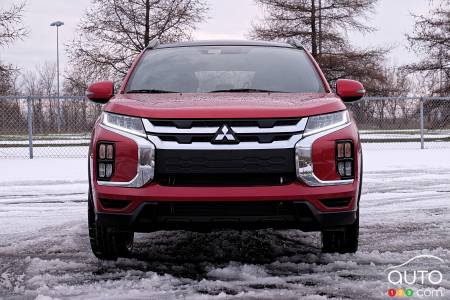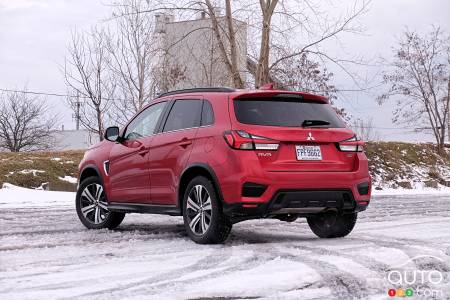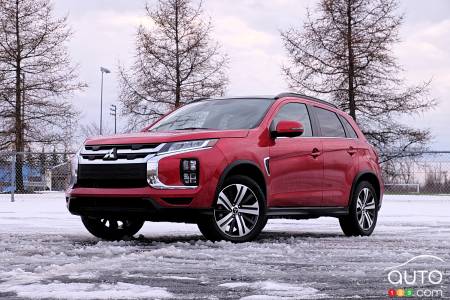Auto123 reviews the 2020 Mitsubishi RVR
The nice thing about positioning yourself as the little guy in the automotive domain is that you can attract self-styled freethinkers, those who prefer not to drive the same brands as everyone else around them. The down side is that chances are you won’t attract that many other folks, who don’t know much about your products and might not trust them.
Such is the lot of Mitsubishi as it toils away trying to claim a market share for itself with a relatively small product line. And yet, the Outlander for example, particularly the PHEV version, is an unmitigated Canadian success story. Those freethinkers like the near-invincibility of Mitsubishi models and the industry-best warranty that comes with them. The affordable price points probably don’t hurt either.
But the Outlander can’t do it alone, and so this year we get a substantially revised (though not wholly new) 2020 Mitsubishi RVR to target those consumers who want a smaller AWD utility model to scoot around in that isn’t a ubiquitous presence on the road.
Auto123 launches Shopicar! All new makes and models and all current promotions.
It’s important to keep in mind that, while the 2020 RVR has been stylistically updated and upgraded inside, it still rides on the same RVR platform and uses the same engines that have been around since 2011; for a car generation, nine years is as long a time as it is for cats and dogs.
What Mitsubishi did do with the 2020 edition, besides sprucing it up as best it could, is to rework the product offering to offer more bang for the buck. Starting price for the base model is a few pennies under $23,000, and the sweet spot for a reasonably priced, well-equipped RVR is the ES AWC version, priced at $25,000.
The looks
Outside you do see some notable differences with the outgoing edition of the RVR, starting with the redesigned front fascia that now features LED lighting and a new grille. The back end has also been revised and does a good job convincing potential buyers this is a dynamic ride that awaits them.

Inside, a less-drastic makeover owes its newness to the addition of new materials and colours, but even more so to the inclusion of Apple CarPlay and Android Auto compatibility via the standard 8-inch touchscreen. Beyond that, this is a simple, straightforward, ergonomically sound interior that kind-of, sort-of follows the traditional recipe employed by Subaru, wherein it’s designed to A) keep the price of the vehicle down, and B) appeal to those who turn their noses up at unnecessary frills.
If you’re looking for cutting-edge technologies galore and a glut of features, buttons and doodads, however, the cabin of the RVR is no place for you.
In the rear part of that cabin, cargo space is pretty mediocre at 569 litres, though it improves to average when you fold down the rear seats, to 1,382 litres. Still, in this area at least, the RVR lags behind a few of its rivals in the subcompact SUV segment, notably the HR-V (1,583 l), the Crosstrek (1,565 l) and even the mousy Mazda CX-3 (1,528 l).
The mechanics
The 2020 RVR works with one of two available engines, starting with a 2.0L 4-cylinder making 148 hp and 145 lb-ft of torque, and ending with a 2.4L unit delivering 168 hp and 167 lb-ft of torque. That one is available only as of the SE AWC version, priced at just under $28,000. Our tester, a range-topping GT AWC (priced at a hair under $34,000), came with that bigger engine.
Not on the menu this year for the RVR is a manual transmission, as it’s been dropped. A CVT (continuously variable transmission) is all that’s left in the product offering, with the boost in fuel economy and the decline in driving pleasure that that brings. Otherwise, the RVR is virtually alone among vehicles of its size in featuring a lockable AWD system, proving that the slightly rough-and-tumble off-road-ready looks of the model aren’t just for show.
By the way, though the feature-laden GT AWC version of the RVR is priced beyond what you really should pay for a small SUV like this, it does have a very large panoramic roof through which light comes pouring into the cabin, a very nice touch for a vehicle in this class.
On the road
Despite the presence of the competent but party-pooping CVT, the 2020 Mitsubishi RVR actually acquits itself quite well on the road in terms of handling and daily-driving enjoyability. Visibility is very good all around thanks to the SUV’s relatively upright stance, and the 2.4L engine’s performance belies its modest raw numbers. Acceleration is decent as long as you don’t mind the whining caused by the CVT, but the body feels fairly rigid, which is a definite plus.
As mentioned, that CVT does help reduce fuel consumption, and really that’s one of the reasons buyers look at a model like this. I averaged 9.3L/100 km over a week that was skewed to city driving, which is quite impressive considering this is an all-wheel-drive configuration and I was driving it in wintertime.
If someone were to describe a vehicle to you as being affordable, built to last and fuel-efficient, equipped with all-wheel-drive and backed by an industry-best warranty, you’d be silly to dismiss it as an option, and the 2020 Mitsubishi RVR deserves to be taken seriously by those in the market for a subcompact SUV.

And yet, though there’s little to criticize about the laudable rejuvenation efforts the carmaker has put into the 2020 edition, the time is coming for a comprehensively new RVR. There’s fresh competition in the segment, and Mitsubishi is in tough against the big boys.
We like
Sporty-ish drive from the rigid chassis, decent engine (2.4L)
Class-best AWD system
Unbeatable warranty
Good fuel economy
Simple, straightforward ergonomics inside
We like less
Cargo space is limited
Fairly noisy cabin on the road
Dearth of advanced tech
Facelift or no, the model is aging
The competition
Chevrolet Trax
Ford EcoSport
Honda HR-V
Hyundai Kona
Jeep Renegade
Mazda CX-3
Nissan Qashqai
Subaru Crosstrek
Toyota C-HR






